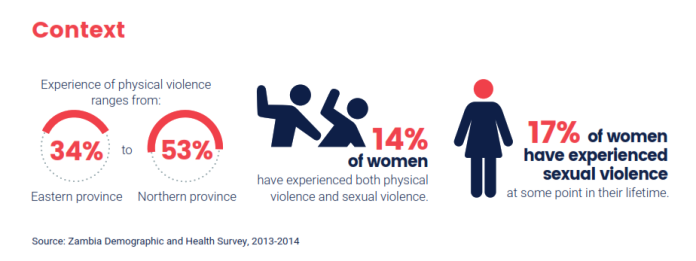Evaluating the Stamping Out and Preventing Gender Based Violence programme
Strengthening evidence base on what works to prevent and respond to gender based violence in Zambia
Project team members
-
DateMarch 2018 - May 2019
-
Areas of expertiseResearch and Evidence (R&E) , Cross-cutting themes
-
CountryZambia
-
KeywordsGender, equality, and social inclusion , Monitoring, Evaluation, and Learning (MEL)
-
PartnerBusara Centre for Behavioural Economics
-
Project number
A2591
Zambia experience relatively high rates of gender-based violence (GBV), compared to other countries in the area. Almost half of all women have experienced physical violence in their lives, usually from a husband or partner. The worrying trends among the young adult population believe that that wife beating is justified under certain circumstances (2014 DHS).

A major challenge in ending GBV is Zambia’s dual legal system, where statutory and customary law co-exist. Under statutory law both sex and marriage under the age of 16 are prohibited, and marriage between the ages of 16 and 20 requires written parental consent. However, under customary law, a child may marry after puberty. Child marriage occurs more frequently in rural areas, where customary law predominates, and in 2014, almost half of women aged 20-49 were married before the age of 18.
The primary objective of the Stamping Out and Preventing Gender Based Violence (STOP GBV) programme was to support the prevention of, and improve the response to GBV, which is a key priority for the Government of Zambia. To help support the government’s plan, the UK’s Department for International Development and the United States Agency for International Development funded this six year programme, which was implemented between 2012 and 2018.
The programme supported the efforts of three implementing partners in reducing GBV at three different stages:
- Providing support services to GBV survivors through a one stop centre model;
- Supporting behavioural change through community outreach to prevent and advocate against GBV;
- Improving the quality and access to legal services for GBV survivors.
We evaluated the systematic efforts invested towards reducing GBV by the three main implementing partners, each approaching GBV either at the prevention, support, or redressal stage.
The challenge
Our evaluation addressed a number of contextual and methodological challenges. Zambia’s multi-sectoral GBV response engages a complex set of stakeholders, and the evaluation design took care to understand the interdependencies and different approaches between government and non-governmental actors involved in the programme’s implementation.
In addition, the social norms that perpetuate GBV and govern whether survivors report or seek help are complex, and tend to change incrementally. This required the evaluation to develop a methodology that could assess the extent to which these norms had changed over time, the mechanisms for that change, and the contribution of the STOP GBV programme’s activities in a context with a growing number of violence prevention initiatives.
Our approach
The main objectives of the evaluation were to:
- Contribute to evidence generation of what works and what does not work in preventing GBV in Zambia, and responding to GBV using the one stop centre model;
- Verify which results achieved are positive or negative, intended or unintended, direct or indirect, and draw out learning points from the programme;
- Determine the extent to which the STOP GBV programme has achieved its intended outcomes as identified in its logframe and assess the quality and effectiveness of implementation.
We carried out a mixed-method, realist, and theory-based evaluation in six districts in Zambia: Choma, Chongwe, Kafue, Katete, Lusaka, and Mumbwa. We employed in-depth interviewing and roundtable discussions to collect qualitative data from implementing partners in order to understand the delivery of the three intervention arms from the supply side. We complemented this data with demand-side data collected via life histories and in-depth interviews in two community studies, carried out in Mumbwa and Lusaka. We also carried out a series of key informant interviews and roundtable discussions with high level stakeholders from the GRZ, the donor sector, and development partner organisations in Lusaka.
Our primary data was triangulated against a review of secondary materials including monitoring and costing data supplied by implementing partners, which also informed a programme concept and management review exercise. Alongside these qualitative approaches an innovative behavioural experiment component was led by the Busara Centre for Behavioural Economics, and carried out in Chongwe, Kafue, Katete, and Lusaka districts. Overall data collection was designed to answer a set of evaluation questions derived from the OECD DAC criteria of relevance, effectiveness, efficiency, impact, and sustainability.
Outcomes
Our work has produced recommendations for DFID, the Zambian Government, and implementing partners working to prevent and respond to GBV.
To help operationalise the evaluation findings, we ran a smaller technical workshop with the implementers of STOP GBV’s successor programme on 5 June 2019. This session scoped concrete strategies for putting the evaluation findings into practice.
